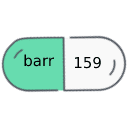Uses
The combination of chlordiazepoxide and clidinium is used along with other medications to treat peptic ulcers, irritable bowel syndrome (IBS; a condition that causes stomach pain, bloating, constipation, and diarrhea), and enterocolitis (swelling in the intestines).
Chlordiazepoxide is in a class of medications called benzodiazepines. It works by decreasing abnormal electrical activity in the brain. Clidinium is in a class of medications called anticholinergics. It helps to decrease stomach spasms and cramps.
Side Effects Of Chlordiazepoxide And Clidinium
Chlordiazepoxide and clidinium may cause side effects. Tell your doctor if any of these symptoms are severe or do not go away:
- weakness or tiredness
- excitement
- anger
- dry mouth
- blurred vision or vision changes
- constipation
- nausea
- difficulty urinating
- changes in sex drive or ability
- irregular menstrual cycles
- coordination problems
- confusion
If you experience any of the following symptoms or those in the IMPORTANT WARNING section, call your doctor immediately:
- slow or difficult speech
- shuffling walk
- persistent, fine tremor or inability to sit still
- difficulty breathing or swallowing
- rash
- swelling of the arms, hands, feet, ankles, or lower legs
- yellowing of the skin or eyes
Warnings & Precautions
Before taking chlordiazepoxide and clidinium:
- tell your doctor and pharmacist if you are allergic to chlordiazepoxide, clidinium, any other medications, or any of the ingredients in chlordiazepoxide and clidinium capsules. Ask your pharmacist for a list of the ingredients.
- tell your doctor and pharmacist what prescription and nonprescription medications, vitamins, nutritional supplements, and herbal products you are taking or plan to take. Be sure to mention any of the following: anticoagulants such as warfarin (Coumadin, Jantoven) or an antipsychotic medication such as chlorpromazine, fluphenazine, or thioridazine. Also, tell your doctor or pharmacist if you are taking or receiving the following monoamine oxidase (MAO) inhibitors or if you have stopped taking them within the past two weeks: isocarboxazid (Marplan), linezolid (Zyvox), methylene blue, phenelzine (Nardil), selegiline (Eldepryl, Emsam, Zelapar), or tranylcypromine (Parnate). Your doctor may need to change the doses of your medications or monitor you carefully for side effects.
- tell your doctor if you have glaucoma, prostatic hypertrophy (an enlarged prostate), or bladder neck obstruction (a blockage of your bladder that causes problems with urination). Your doctor will probably tell you not to take chlordiazepoxide and clidinium.
- tell your doctor if you have or have ever had vision problems, urinary problems, or kidney or liver disease.
- tell your doctor if you are pregnant or plan to become pregnant. If you become pregnant while taking this medication, call your doctor immediately. Clidinium-containing medications may cause fetal harm.
- tell your doctor if you are breastfeeding. Clidinium-containing medications may decrease your breast milk production.
- talk to your doctor about the risks and benefits of taking chlordiazepoxide and clidinium if you are 65 years of age or older. Older adults should not usually take chlordiazepoxide and clidinium because it is not as safe or effective as other medication(s) that can be used to treat the same condition.
- you should know that this medication may make you drowsy. Do not drive a car or operate machinery until you know how it affects you.
Dosage Of Chlordiazepoxide And Clidinium
The combination of chlordiazepoxide and clidinium comes as a capsule to be taken by mouth. It usually is taken three or four times a day, before meals and at bedtime. Follow the directions on your prescription label carefully, and ask your doctor or pharmacist to explain any part you do not understand. Take chlordiazepoxide and clidinium exactly as directed.
Do not stop taking chlordiazepoxide and clidinium without talking to your doctor. If you suddenly stop taking chlordiazepoxide and clidinium, you may experience withdrawal symptoms such as seizures, shaking, stomach cramps, muscle cramps, depression, vomiting, difficulty falling asleep or staying asleep, and sweats. Your doctor will probably decrease your dose gradually.
Chlordiazepoxide and clidinium may be habit-forming. Do not use more of it, use it more often, or use it in a different way than directed by your doctor. Tell your doctor if you or anyone in your family drinks or has ever drunk large amounts of alcohol, uses or has ever used street drugs, or has overused prescription medications, or if you have or have ever had depression or another mental illness. There is a greater risk that you will overuse chlordiazepoxide and clidinium if you have or have ever had any of these conditions.
Your doctor or pharmacist will give you the manufacturer’s patient information sheet (Medication Guide) when you begin treatment with chlordiazepoxide and clidinium and each time you fill your prescription.
Other
Keep all appointments with your doctor. Your doctor will order certain lab tests to check your response to chlordiazepoxide and clidinium.
Do not let anyone else take your medication. Ask your pharmacist any questions you have about refilling your prescription.
It is important for you to keep a written list of all of the prescription and nonprescription (over-the-counter) medicines you are taking, as well as any products such as vitamins, minerals, or other dietary supplements. You should bring this list with you each time you visit a doctor or if you are admitted to a hospital. It is also important information to carry with you in case of emergencies.
Source
All information has been provided courtesy of MedLinePlus from the National Library of Medicine and from the FDA.



